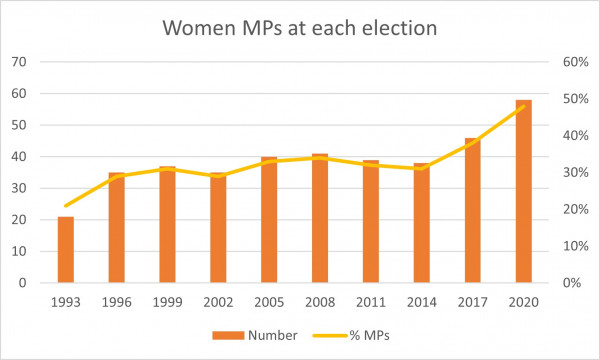MMP has resulted in a more diverse Parliament. The party lists drawn up by political parties include more women, and more Māori, Pasifika and Asian candidates, ensuring their representation in the House.
Women in Parliament
Women in New Zealand won the right to vote in 1893, but it wasn’t until 1919 that they could stand for Parliament. The first woman member of Parliament was elected in 1933.
The number of women MPs started to increase from the 1980s. Since the change to MMP, the proportion of women in Parliament has risen and today, almost half of MPs (48%) are women.

Data source: Te Ara Numbers of women MPs - Te Ara: The Encyclopedia of New Zealand
Read more about the history of women in Parliament - New Zealand History
Māori representation under MMP
Māori representation in Parliament began in 1867 when four Māori electorates were established.
Today, Māori MPs are elected to Parliament from the Māori electorates, general electorates and party lists.
The Royal Commission on the Electoral System said there would be no need for the Māori electorates if MMP was adopted.
However, there was strong opposition from Māori to abolishing the seats. Parliament decided to retain the seats. It also decided that the number of Māori electorates should be linked to the number of people on the Māori electoral roll. There are currently seven Māori electorates.

Data source: New Zealand Parliament
Other places you can go to learn more about the history of Māori representation are:
- Ngā māngai - Māori representation - Te Ara, The Encyclopaedia of New Zealand
- Māori and the vote - New Zealand History
Pasifika and Asian MPs
The proportion of our Parliament made up of Pasifika and Asian MPs has also increased steadily under MMP.
The number of Pasifika MPs has risen from one in 1993 to 11 in 2020. The number of MPs of Asian descent has risen from one in 1996 to eight in 2020.

Read more about the ethnic diversity of MPs - Te Ara: The New Zealand Encyclopedia
